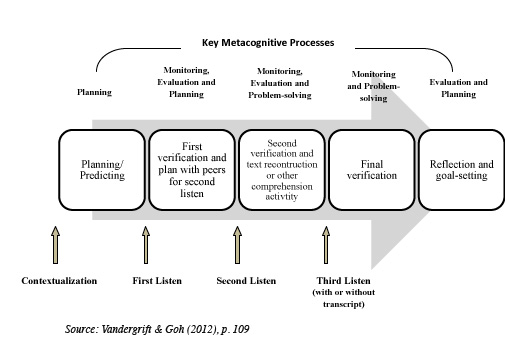View Content #18795
| Contentid | 18795 |
|---|---|
| Content Type | 4 |
| Title | Sample Activity for Listening: Bottom-Up |
| Body | by Larry Vandergrift This week's InterCom features two Activities of the Week focusing on listening. In both activities, students are led through the process of listening: predicting, monitoring, problem solving and evaluating. They are developing their metacognitive awareness of listening, leading them to become the smart listeners envisioned in Principle 1 of the Topic of the Week article. See the key stages and the related metacognitive process illustrated in the Figure below.
Key stages in the metacognitive pedagogical sequence, and the corresponding metacognitive processes, for listening instruction as exemplified in the two listening activities. Activity 2: While Activity 1 focused on a ‘top-down’ approach to listening; that is, using the context and text-type to predict content, based on world knowledge, discourse knowledge and metacognition to arrive at reasonable interpretation of the text, Activity 2 focuses on a ‘bottom-up’ approach to listening. In this case, students use a decoding approach to complete a listening activity based on a text where words have been deleted. This kind of ‘cloze activity’ is commonly used but students are not often encouraged to engage in a metacognitive approach to task completion. The activity below, ‘Camping,' is only a suggestion for illustration purposes since teachers will likely use a text related to the theme currently under study and geared to the language proficiency of the students. If a recorded text is not available, the teacher can read the text. While teachers often begin such an activity without any preparation other than ‘Listen and fill in the missing words’, it can be made more meaningful and more metacognitive in orientation. Teachers are encouraged to proceed as follows:
Camping When the weather starts to get warm, many families like to experience the __________ air of the country away from the ______________ of the city. They pack up their ____________ and a _____________ full of food and head out to the woods near a body of water such as a ___________ or a _______________. After arriving at the _____________, the first thing to do is ___________ up the _______________. At night, people sit around the ____________ and __________ scary stories or _____________ songs. Somebody has to ____________ wood for the fire. To do this, they’ll need an _______________. If anybody gets hungry, they can ____________ hotdogs or ______________ over the fire. One thing people like to do in the woods is put on their boots and go ______________. Another thing they like to do is grab a rod, some hooks, and some worms and go ________________. (Adapted from www.bogglesworldesl.com) |
| Source | CASLS Activity of the Week |
| Inputdate | 2015-01-02 18:41:05 |
| Lastmodifieddate | 2015-01-05 09:32:02 |
| Expdate | Not set |
| Publishdate | 2015-01-05 02:15:01 |
| Displaydate | 2015-01-05 00:00:00 |
| Active | 1 |
| Emailed | 1 |
| Isarchived | 0 |

